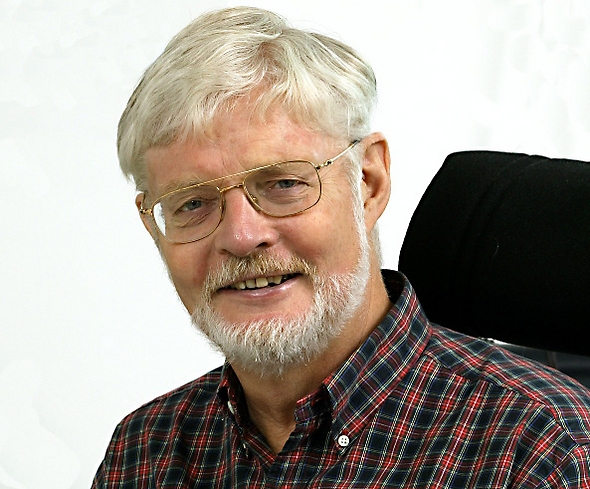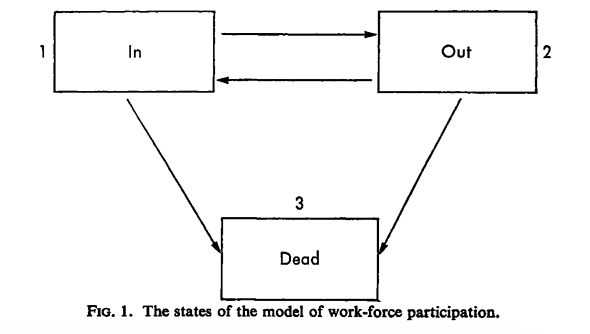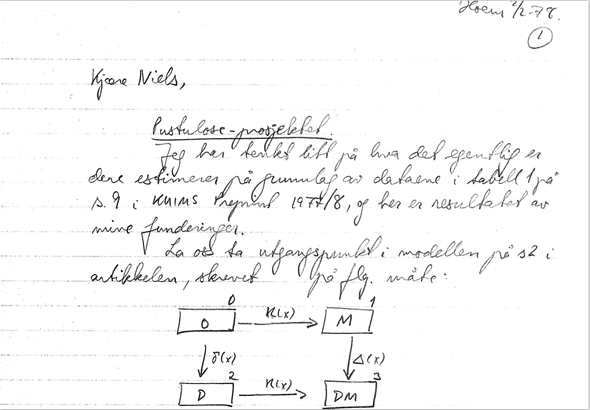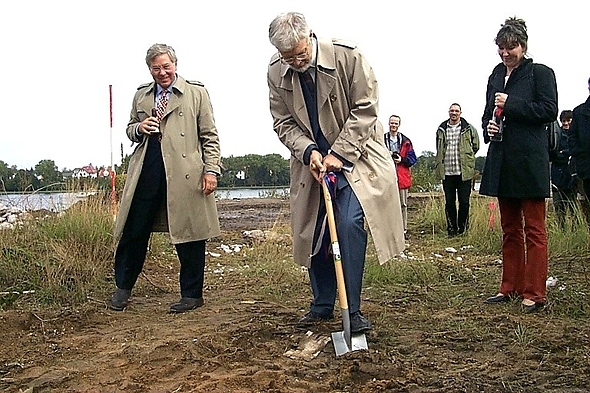October 04, 2017 | News | Former MPIDR Director
Jan Hoem
On April 11, 2017, the MPIDR held a workshop in memory of its former Director Jan Hoem, who passed away at the end of February of this year. Here we have summarized some impressions of the event.

© MPIDR
More than 50 participants attended the commemorative symposium, which was scheduled to take place shortly after Hoem’s death. Friends, colleagues, and students paid tribute to Hoem’s work and found very personal words to say in bidding farewell to the influential demographer.
“Even though we arranged this event on very short notice, I think it’s a testament to how important, influential, and also how loved Jan was in the scientific community that we managed to get these undoubtedly very busy people to come here and share their thoughts,” MPIDR Executive Director Mikko Myrskylä said in his introductory words.
MPIDR Director James W. Vaupel highlighted the key role played by Jan Hoem in the institute's history:
“When Jan came to the institute, it was only three years old; still a baby. And then, over the eight-year period that Jan was here, the institute developed into something serious. Jan filled this building. The institute became the world’s best demographic institute in the three areas that we cared most about: birth, death, and mathematics. When I think back on these years, these are to me the golden years of the institute.”
Niels Keiding from the University of Copenhagen and Gunnar Andersson from the University of Stockholm gave lectures about the two main stages of Jan Hoem’s professional life.
Keiding talked about Hoem's early career in research at the University of Oslo and at the statistical Federal Office of Norway. He also spoke of their time together at the University of Copenhagen, where Hoem conducted research on event-history analysis and actuarial mathematics. A transcript of the entire talk and the slides that accompanied the presentation are available here (PDF File, 1 MB).
Andersson reported on the subsequent stage of Hoem’s career, during which he applied his mathematical methods to demographics. Hoem spent this phase of his life at the University of Stockholm, where he founded the demographic unit of the university; and later as director of the MPIDR. A transcript of the entire talk and the slides that accompanied the presentation are available here (PDF File, 1 MB).
In addition to Keiding, Andersson, and the two directors of the MPIDR, Karl Ulrich Mayer, Vladimir Shkolnikov, Andres Vikat, Zsolt Spéder, and Michaela Kreyenfeld spoke at the event. Gunnar Andersson read a contribution from Sunnee Billingsley, who could not be present. Laura Bernardi, who was also unable to attend the event, sent a video message.
The speakers’ heartfelt words about Jan Hoem’s life and work were a testament to his huge influence on the discipline, and on the researchers he interacted with over the course of his career.
In his speech, Keiding discussed the methodologists who influenced Hoem, and mentioned some of the famous mathematicians and demographers who were his students, including Erling Sverdrup, Tore Schweder, Odd Aalen, Ørnulf Borgan, and Henrik Ramlau-Hansen. Keiding pointed out that the diagrams of boxes and arrows, which are today often used in demography to illustrate complex relationships in a highly simplified manner, were first used by Hoem.

This figure was part of an article published by Jan Hoem in 1971 in the Journal of the Royal Statistical Society. Jan Hoem was the first to use these kind of diagrams of boxes and arrows, which are today common in demography.
He also showed images of Hoem's handwritten notes and comments that demonstrate his meticulous work.

Some of Jan Hoem's handwritten notes.
Keiding emphasized the important role Jan Hoem played in the training of young scientists:
“Jan showed us how to use event-history analysis in analyzing demographic data; he was generous in guiding and promoting promising young statisticians interested in demography and actuarial mathematics.”
Andersson reported on Hoem's time in Stockholm, recounting how his research focus started to shift towards the social sciences. Hoem had accepted a professorship in demometry at the university. His professorship was originally in the department of mathematics. But because he felt he did not fit in well there, he moved to the sociology department. Andersson stressed that Hoem contributed substantially to building up the research infrastructure of the university:
“He devoted a lot of time and energy to developing infrastructures for research. He organized the Fertility and Family Survey in 1992, together with the demographics and Statistics Sweden, which gave us survey data on new family demographic trends for research. He also pioneered register data together with Statistics Sweden. Today, register data are highly developed, but he had developed and pioneered this type of research.”
Andersson also told the audience about Hoem’s very special tendency to link his results with explanations and illustrative examples in his publications:
“When he was writing articles, he combined education or instruction with event analysis by applying the new methods in event-history techniques and giving examples of how the methods can be applied to demographic topics.”
Vaupel also emphasized Hoem's exceptional ability to work with data and figures:
“He contributed to the mathematics of event-history analysis. But what most impressed me, was his deep understanding of figures. He had a feel for the record; for the datasheet he was looking at. He had a profound understanding – Gefühl – for this kind of data that I have never seen in anybody else.”
Karl Ulrich Mayer, former president of the Leibniz Association, played a key role in the history of the MPIDR, as it was upon his suggestion that the Max Planck Society decided to establish the institute. Mayer recalled that Jan Hoem had inspired him to make this proposal, in part through an incident at a meeting:
“Jan Hoem interrupted a speaker in a presentation on multi-state life tables several times by pointing out that what he presented as an innovation had already been discovered or proposed by a Danish, Norwegian, or Swedish actuary at various times in the 19th century. We were all stunned – and delighted – by this boldness, as we would be many times in the years to come.”
Mayer said that this incident, together with his very positive assessment of Hoem's publications, had prompted him to propose the founding of the MPIDR.

Jan Hoem and Jim W. Vaupel at the groundbreaking ceremony for the MPIDR building in Rostock.
Zsolt Spéder, Director of the Hungarian Institute of Demography, met Hoem when they were working together on the Generations and Gender Program (GGP). The GGP is an international longitudinal study covering 24 countries that gathers data on the relationships between parents and children and between partners, as well as on the factors that influence these relationships. He emphasized Hoem's important role in the establishment of the program:
“Jan’s personal involvement was one the main drivers for the establishment of the Generations and Gender Program, which is one of the most important data resources in comparative family and fertility research.”
Spéder also stressed how much Jan Hoem had shaped and prompted event-related analyses, and how important developing this method has been for demographers and sociologists:
“Event-history methods help us to extend the borders of the territories of our disciplines.”
All of the speakers commented on the human side of Jan Hoem. They described him as a very warm, humorous person who cared greatly about the people who were working with him. But they also recounted his intolerance of possible mistakes. As the scientific discourse was very important to him, he was never willing to overlook errors.
Sunnee Billingsley, a demographer at the University of Stockholm who was a PhD student of Hoem’s, recalled an incident that showed how little he cared about hierarchy. Rather than putting them in their place, Hoem encouraged his doctoral students to be independent and self-assured:
“He was always interested in what students and young researchers were thinking and exploring. In fact, when I was a doctoral student and was deciding between Stockholm and a UK university for a postdoc position, he encouraged me to write the superstar professor I was interested in to find out if there was a potential for collaboration. When I did that I received an irritated and dismissive response – which was somewhat expected, and I had to laugh a bit about how having a different status worked in some departments. While Jan’s egalitarian approach may not be as widespread as he thought, it was one of his great traits and a lovely vision of what could be.”
Andres Vikat, who now heads the Social and Demographic Statistics at the United Nations Economic Commission for Europe (UNECE), met Hoem for the first time in 1991. At that time, Estonia had just gained independence, and Hoem visited the young country with a delegation of Swedish demographers and social scientists. Vikat remembered the great pleasure Hoem took in scientific discourse:
“He interrupted about every second presentation that was quantitative enough that he cared about it. While he made his point in a very warm way, he made it clear from the beginning that no mistake would go unspotted. Those of us who were not too shy to get into close conversations with him also understood what a nice and kind professor he was, and how much patience he had for explaining the complicated issues of demography.”
The other speakers also recalled Hoem’s willingness to explain his research and discuss it with people at all stages of their scientific careers. He spent a lot of time writing lecture notes, and used his position to help other scientists gain access to resources and advance their careers.
According to Vikat, Hoem did a lot for demography in the Baltic states. For example, he invited large numbers of scientists from these newly independent countries to attend a colloquium in Lund, which was a novel experience for them. Vikat worked with Hoem in two different settings: first as a postdoctoral researcher in Stockholm in 1996 and 1997, and again from 2000 to 2005 at the MPIDR:
“He was an outstanding researcher. But what dominates my recollection is that team spirit of mutual support and collaboration, the warm working atmosphere that made arriving each morning the most pleasant part of the day, and how he discovered and appreciated the strong sides of all of us.”
In discussing Hoem’s achievements, Vikat also mentioned the Generations and Gender Program, and especially the way in which he organized the project to facilitate research:
“In summer 2000, Jan got a call from the United Nations, where his expertise was requested for building a new pan-European program of data collection and research on family, fertility, and intergenerational relationships. This request was to him personally, to act as consultant to the United Nations. Jan saw this issue as being much broader than that, as he realized that this program could become a core activity of his team and an important pillar for future research on fertility and family dynamics. He transformed this activity into a joint endeavor; developing a program with a vision for the future in order to provide data for current and future generations of researchers.”
According to Vikat, some 1,200 papers that draw upon data from the Generations and Gender Program have been published so far.
Vladimir Shkolnikov met Hoem in 1999, when he applied for a position at the institute. He recalled that Hoem was very concerned about the exchange between the scientists, and that these efforts also bore fruit:
“Jan was an engine of the dynamic scientific life at the institute. Jan highly promoted communication and interaction at the institute. Every week there was a meeting of the heads of groups of his division, which seems quite frequent. But this frequency allowed people to keep in permanent contact and to use their collective potential to generate good ideas, such as the contextual database for the GGP, or the idea of taking over the legacy of the European demography observatory from INED. Many of these projects were long-living and quite influential.”
Michaela Kreyenfeld, who now holds a sociology professorship at the Hertie School of Governance, was a PhD student and postdoctoral researcher at the MPIDR. She highlighted the interdisciplinary approach that Hoem had made the key principle of his research:
“Jan was dedicated to event-history analysis in teaching and research. No question, he was a leading scholar in this field. His mission was, however, not limited to moving demography forward. Most importantly, he reached out to other disciplines. That is evident not only from the composition and work of Jan’s group on ‘Contemporary European Fertility and Family Dynamics’, but from the many projects that he conducted with junior and senior scholars from various disciplines. He was a truly interdisciplinary scholar able to bridge the disciplines.”
All the contributors also shared personal memories of their interactions with Hoem:
Mikko Myrskylä: “My own career, unfortunately, overlapped with Jan’s very little. I started my PhD studies just a year before Jan retired from this institute, so I wasn’t able to benefit directly from his mentorship or his leadership. But I heard from others that both as a colleague and as a mentor he was absolutely outstanding.”
Jim Vaupel: “I valued his wisdom, his judgment, his generosity. He wasn’t ambitious for himself, he wasn’t greedy for himself. He wanted to help the institute. And he really did a good job.”
Zsolt Spéder: “He was a warm and friendly person and he liked to amuse people. He was tolerant, but he was also determined – hartnäckig – at the same time. We will miss and we will remember him in our discipline.”
Andres Vikat: “His legacy goes much beyond his own direct scientific work and the work produced under his supervision. His legacy is carried on by the many people he has taught and inspired and who have learned from him not only the finesses of event-history analysis, but how to make our professional lives enjoyable.”
Sunnee Billingsley: “I am lucky to have gotten to know Jan and am honored to have had him as my mentor and friend.”
Karl Ulrich Mayer: “That is how I will remember him: stern and forthright, with this twinkle of irony and humor in his eyes. It was a privilege to know him and to learn from him.”
Vladimir Shkolnikov: “Jan was a really kind and an egalitarian person, who always helped people in difficulties. Jan was an outstanding director for the institute. I believe that people who had the privilege to work with him will keep warm and encouraging memories of him.”
Michaela Kreyenfeld: “Jan is a great loss to demography. However, Jan’s spirit continues to live in our research and teaching. In my own lectures, I am still talking fondly of my Swedish-Norwegian Professor who rewarded us with Finnish chocolate. All I can say is that I am proud and honored to have known Jan and to have been one of his students.”
The closing remarks were made in a very moving video statement by Laura Bernardi, who was first a PhD student at the MPIDR and then a Max Planck Research Group leader in Jan Hoem's division, and who is now deputy director of the Swiss National Centre of Competence in Research LIVES:
“Today I would like to talk about four lessons that I will always be grateful for as a professional academic. First, you taught me that science is not only adding new pieces of knowledge, but also looking at old pieces of knowledge in different ways, putting them together in different ways. I learned by observing you to encourage interdisciplinary work even when that meant entering very risky pathways. Second, I learned that young scholars often need to be encouraged by their teachers. Now that I belong to the old teachers, I understand much better why you were restlessly supportive and patient with all of us. Third, I learned that difference is no reason for exclusion, especially in science, especially in academics. I learned that when you were listening to, including, and respecting all those diverse ideas circulating in your laboratory. And fourth, laughing. I learned that laughing shall be part of academic life, you were so consciously, respectfully laughing about science and scientists and whatever was considered to be politically correct. This has been so helpful to me, every time I overrated, overreacted to, and overinterpreted things, I always had in mind Jan laughing them away.”
For an overview of Jan Hoem’s scientific work, go to his personal page, where all of his publications are listed.
More Information
- Commented slides of Niels Keiding's Talk pdf (PDF File, 1 MB)
- Commented slides of Gunnar Andersson's Talk pdf (PDF File, 1 MB)
- Jan Hoem's personal webpage with a detailed CV and a list of all his publications
- Obituary by Jim Vaupel, founding director of the MPIDR